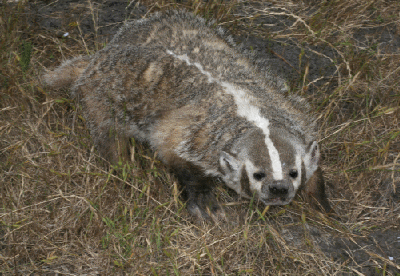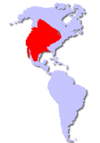 SKC Films Library |
| SKC Films Library >> Order Carnivora >> Family Mustelidae |
| American Badger Taxidea taxus Description This badger has a stocky 3-foot body, short tail and short but powerful legs armed with strong claws on the front feet. It is 16 to 28 inches long, and weighs up to 26 pounds. The coat is grayish to reddish-brown in color, with a white throat, buff-colored underside, dark brown to black feet, and black and white markings on the face. The muzzle is black, with two black stripes extending from the nose over the eyes and blending to gray on the back. A white stripe extends from the nose, along the top of head and over its back. This stripe is what most distinguishes the American badger from the Eurasian badger.
Distribution and Habitat The American badger ranges from southern Canada through the western United States and into Mexico. It prefers areas of open grassland and deciduous woodlands, but has been seen in mountainous areas, marshes, farmlands, and deserts.
Diet Badgers feed on small mammals (especially burrowing rodents), ground nesting birds and their eggs, reptiles, and insects and their larvae. Prey is primarily obtained by digging. Plant foods include windfall apples, bulbs, acorns, blackberries, grasses and cereals, and some fungi. Habits and Behaviors The American badger is a solitary animal. Individual badgers establish home ranges, but they are not territorial. Like all other badgers, the American badger is truly nocturnal, almost never being seen outside of its den during the day. If there is any disturbance, suspicious sound or scent, the badger may remain underground for the night, and may not even come out on bright moonlit nights. Badgers have multiple setts (dens) within their home range that are used for sleeping. A sett can be up to 10 feet below the surface and contain up to 30 feet of tunnels, with an enlarged chamber for sleeping. Several side tunnels are used as latrines. A badger may use several different setts during the summer, but generally settles down in only one during the winter. Reproduction Mating occurs in summer to early autumn, but the embryos do not begin to develop until December or January. The pregnancy lasts about seven months, but the actual gestation period lasts only six weeks. One to five young are born in February or March. For the first six to eight weeks of life they stay underground, then make their first, tentative visits to the outside world. At first they stay out for only a very short time, but after a week or so they become bolder and start exploring the neighborhood. Scientific Classification phylum Chordata SEE ALSO |
| SKC Films Library >> Order Carnivora >> Family Mustelidae This page was last updated on June 19, 2018. |

